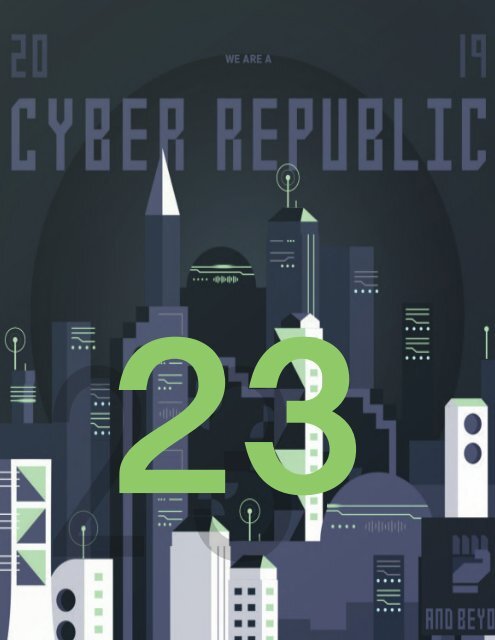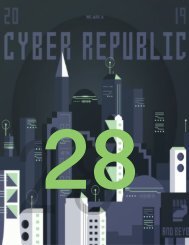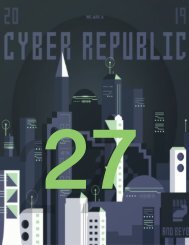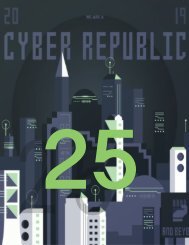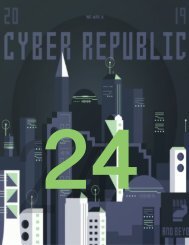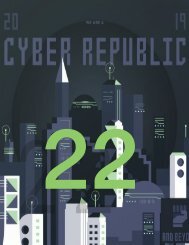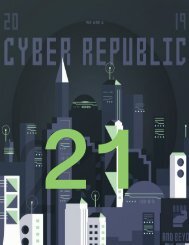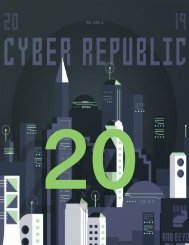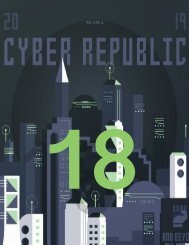Cyber Republic Weekly Update 23
Elections are already underway and members of the Cyber Republic are getting excited for Phase 5,when elected DPoS nodes will fully be deployed and begin finalizing Elastos’ Dual AuxPOW and DPoS Consensus mechanism. This week, the Elastos in a Nutshell Team came out with a comprehensive video and article about Computer Networks and how it relates to Elastos Carrier. Popular YouTuber Crypto Lark released with an all encompassing Elastos video that was very well received by the community, as it was fair in both praise and critique of Elastos. The Elastos private net has been fully updated. The ELA Republic, an Elastos Community Telegram Group, hosted Elastos’ Feng Han in an AMA. We also have an interview with Su Yipeng--Interim Council Member of the CR, updates from the Philippines community, a discussion on FUD and potential vectors of manipulation in DPoS voting and Consensus, an update on CR Partner Hyper and the DPoS Rewards Script being programmed, and we’ll also be breaking down the Elastos affiliated wallets and what differentiates them.
Elections are already underway and members of the Cyber Republic are getting excited for Phase 5,when elected DPoS nodes will fully be deployed and begin finalizing Elastos’ Dual AuxPOW and DPoS Consensus mechanism. This week, the Elastos in a Nutshell Team came out with a comprehensive video and article about Computer Networks and how it relates to Elastos Carrier. Popular YouTuber Crypto Lark released with an all encompassing Elastos video that was very well received by the community, as it was fair in both praise and critique of Elastos. The Elastos private net has been fully updated. The ELA Republic, an Elastos Community Telegram Group, hosted Elastos’ Feng Han in an AMA. We also have an interview with Su Yipeng--Interim Council Member of the CR, updates from the Philippines community, a discussion on FUD and potential vectors of manipulation in DPoS voting and Consensus, an update on CR Partner Hyper and the DPoS Rewards Script being programmed, and we’ll also be breaking down the Elastos affiliated wallets and what differentiates them.
- No tags were found...
You also want an ePaper? Increase the reach of your titles
YUMPU automatically turns print PDFs into web optimized ePapers that Google loves.
<strong>23</strong><br />
//1
CYBER REPUBLIC <strong>Weekly</strong> <strong>Update</strong>/Issue 22<br />
Elastos Philippines makes an appearance at a cosplay competition during ITamGameCon<br />
2019, an intercollegiate Games and eSports Tournament which hosts games such as<br />
Counterstrike, DOTA, League of Legends,Tekken, Pokemon, Magic the Gathering, Dungeons<br />
and Dragons, Warhammer 40,000, and Catan.<br />
Elections are already underway and members<br />
of the <strong>Cyber</strong> <strong>Republic</strong> are getting excited for<br />
Phase 5,when elected DPoS nodes will fully be<br />
deployed and begin finalizing Elastos’ Dual<br />
AuxPOW and DPoS Consensus mechanism.<br />
This week, the Elastos in a Nutshell Team came<br />
out with a comprehensive video and article<br />
about Computer Networks and how it relates<br />
to Elastos Carrier. Popular YouTuber Crypto<br />
Lark released with an all encompassing Elastos<br />
video that was very well received by the<br />
community, as it was fair in both praise and<br />
critique of Elastos. The Elastos private net has<br />
been fully updated. The ELA <strong>Republic</strong>, an<br />
Elastos Community Telegram Group, hosted<br />
Elastos’ Feng Han in an AMA.<br />
We also have an interview with Su Yipeng--<br />
Interim Council Member of the CR, updates<br />
from the Philippines community, a discussion<br />
on FUD and potential vectors of manipulation<br />
in DPoS voting and Consensus, an update on<br />
CR Partner Hyper and the DPoS Rewards Script<br />
being programmed, and we’ll also be breaking<br />
down the Elastos affiliated wallets and what<br />
differentiates them.<br />
Let’s get to it.<br />
This week the Elastos in a Nutshell team came<br />
out with a very well-done article and video on<br />
Part 1 of the Elastos Carrier. The video was<br />
done by CR Press team member Amos, and you<br />
can view it here:<br />
https://www.youtube.com/watch?v=BjNJS3jYM<br />
UU&t=1s<br />
He explains the basics of computer networks<br />
and breaks down various network<br />
architectures. The most important aspect of<br />
the analysis is the explanation of TCP/IP and<br />
how it allows communication through the<br />
internet.<br />
Part 1 of the article can be found here:<br />
https://blog.cyberrepublic.org/2019/04/25/elast<br />
os-in-a-nutshell-a-laymans-perspective-peer-<br />
//2
to-peer-carrier-network-part-1/<br />
The team is formed by Charles Coombs, Amos<br />
Thomas, Michael Ekpo and Eric Coombs Esmail.<br />
Popular crypto Youtuber, The Crypto Lark,<br />
reviewed Elastos and the <strong>Cyber</strong> <strong>Republic</strong> this<br />
w e e k .<br />
https://www.youtube.com/watch?v=oKjMjnW8P<br />
TY&t=942s<br />
He does a very thorough job covering multiple<br />
aspects of Elastos. He goes over the TV Boxes as<br />
carrier nodes, how Supernode Voting is live,<br />
briefly explains Elastos Trinity Browser and<br />
Elastos Carrier, and gives info on the Manhatten<br />
Project,Viewchain, ioeX, Quube TV, World Bank,<br />
and the <strong>Cyber</strong> <strong>Republic</strong>!<br />
He does bring a few criticisms forward. These<br />
topics include Exchange listings, low liquidity,<br />
no new airdrops because of regulatory fears, a<br />
large lack in communication. However, he’s<br />
optimistic that the CR, lead by our very own<br />
weekly reports, will make up for this. Thanks to<br />
Crypto Lark for taking the time to review the<br />
project!<br />
The Elastos private net has recently been<br />
updated. The following are new features of the<br />
Elastos private net:<br />
- Supports both CRC and Elected supernodes<br />
- Rough example showcasing how to run a<br />
supernode on private net<br />
- Rough example showing how to vote for a<br />
supernode<br />
-Two registered supernodes with some votes<br />
already casted<br />
- <strong>Update</strong>d README with more documentation<br />
on the latest changes<br />
Feel free to give it a try and report any issues at:<br />
configurations may vary depending on your<br />
setup.<br />
Feel free to check out the new Elastos Private<br />
net here:<br />
Elastos Foundation’s Feng Han conducted an<br />
AMA with community member Jon Snow this<br />
week. Some highlights include: Feng Han will be<br />
visiting Huawei next month where he was<br />
invited to give a speech. He hopes to inspire<br />
Huawei’s thoughts on the bold vision of Elastos.<br />
He mentions the Elephant wallet and how it will<br />
play a major role in enabling ELA support to all<br />
dapps. Feng also shares his experience joining<br />
the Elastos Foundation and why he believes in<br />
Rong Chen and the project overall. Check out<br />
the full Feng Han AMA on Telegram<br />
@ELAREPUBLICAMA<br />
As always, there’s a brand new Elastos <strong>Weekly</strong><br />
<strong>Update</strong> that we always include in the Summary<br />
section of our <strong>Weekly</strong> <strong>Update</strong>s:<br />
Make sure to check it out for the massive<br />
amounts of technical updates, from Trinity and<br />
Hive to the Sidechain and DPoS Testing and<br />
Deployment.<br />
Reminder:We are no longer listing all supernode<br />
candidates from prior weeks in our newsletter.<br />
In the future, supernode lists will reside on our<br />
new website, https://news.cyberrepublic.org.<br />
If you would like to submit your supernode,<br />
supernode rewards, or supernode community<br />
contributions, please reach out to us through<br />
our forum at:<br />
https://github.com/cyber-republic/elastosprivnet/issues<br />
https://github.com/cyber-republic/elastosprivnet<br />
https://news.elastos.org/elastos-weeklyupdates-26-april-2019/<br />
https://forum.cyberrepublic.org/c/cyberrepublic-teams/cr-press<br />
Or email us at press@cyberrepublic.com.<br />
Also, a video will be released separately on how<br />
to run a supernode locally. Actual<br />
-By Jeremy G.<br />
//3
CYBER REPUBLIC <strong>Weekly</strong> <strong>Update</strong>/Issue 22<br />
Table of Contents<br />
2 Intro<br />
5 Summary<br />
6 Hyper <strong>Update</strong><br />
10 Getting Ahead of the FUD<br />
15 CR Terminology: DApp<br />
17 Interview: Su Yipeng<br />
20 International Community<br />
25 Community Shout Out!<br />
26 Analytics<br />
28 Forum<br />
33 Glossary<br />
35 Credits<br />
//4
Summary<br />
Read last week’s update on our website:<br />
https://news.cyberrepublic.org/22ndweeklyreport/<br />
Here is the latest Elastos Foundation <strong>Weekly</strong> <strong>Update</strong>:<br />
https://news.elastos.org/elastos-weekly-updates-26-april-2019/<br />
We have a new <strong>Cyber</strong> <strong>Republic</strong> Documentation site with relevant introductory information<br />
about the <strong>Cyber</strong> <strong>Republic</strong>, including the constitution, voting and proposals, and leadership.<br />
Check it out here:<br />
https://www.cyberrepublic.org/docs/#/overview/intro<br />
Project <strong>Update</strong>s<br />
<strong>Cyber</strong> <strong>Republic</strong> Website<br />
Main Project Repo: https://github.com/cyber-republic/<strong>Cyber</strong><strong>Republic</strong><br />
Git Activity and <strong>Update</strong>s<br />
Please refer to the timeline described on this article for more info:<br />
https://blog.cyberrepublic.org/2018/12/27/important-cyber-republic-announcement<br />
If you are a developer interested in working with the CR or Elastos, here’s a form you can fill<br />
out: https://goo.gl/forms/pvzDYMsVEs10s6U72<br />
If you have any content you’d like to submit to our team, please email us at:<br />
press@cyberrepublic.org<br />
//5
CYBER REPUBLIC <strong>Weekly</strong> <strong>Update</strong>/Issue 22<br />
Hyper <strong>Update</strong><br />
One of the storybook projects of the <strong>Cyber</strong> <strong>Republic</strong> has been Hyper. It’s a team that has two<br />
projects with heavy utility for the ecosystem. Hyper.IM Messenger is a peer-to-peer chat dapp.<br />
Hyper Connect is built on Elastos and works to control IoT devices and sensors and any other<br />
smart hardware. The CR <strong>Weekly</strong> interviewed Hyper team member Peter Strauss a couple of<br />
months ago. We’ve followed up with Mr. Strauss to get updates about the Hyper projects and we<br />
also will be grabbing a few details about the progress of the highly-anticipated Reward Payout<br />
scripts Mr. Strauss is creating for Supernodes.<br />
Press Release<br />
Hyper Messenger<br />
The iOS Beta version for Hyper Messenger has recently been released via Apple’s TestFlight<br />
testing solution and has now over 120 active installations. The messenger application for iOS<br />
can be downloaded here: https://testflight.apple.com/join/skojiwxw<br />
File sharing will also be added to the iOS version soon, as well as offline messaging support for<br />
both iOS and Android.<br />
In addition, the integration with the Elephant Wallet to initiate transactions, receive and follow<br />
the status of the transactions will soon follow.Cryptocurrencies will be entirely managed by the<br />
Elephant Wallet, and for each initiated transaction via Hyper Messenger, the approval of the<br />
transaction via the Elephant Wallet will be required to enable maximum security.<br />
An important milestone for the Android version has been reached as over 2500 users now use<br />
Hyper Messenger while still in Beta.<br />
HyperConnect<br />
We are also nearing completion of the first milestone for the HyperConnect project. The Edge<br />
Client, which is the software component that runs on the IoT devices, is ready and will be<br />
released entirely open-source on the <strong>Cyber</strong><strong>Republic</strong> Github next week with documentation<br />
and tutorials.<br />
The goal of the HyperConnect Edge Client is to enable anyone to easily set up, manage, and have<br />
an overview of the IoT devices and its sensors via a Graphical User Interface (GUI) with minimal<br />
to no coding.<br />
Sensors<br />
The Sensor overview allows the grouping and management of different sensor types with<br />
different attributes. For example, while reading values from a temperature sensor we may<br />
//6
collect, store and process integer value readings, we define the data direction to be an ‘input’, as<br />
the data flow is from the sensor to the device.<br />
By defining the LED as an output attribute, we are able to give commands to the LED. In contrast<br />
to ‘input’ direction, we do not read data from the LED, we only give commands, so the data flow<br />
direction is from the device to the sensor.<br />
History / Overview<br />
We may also follow the real-time as well as averaged values in different time-frames for the<br />
temperature sensor.<br />
With the future release of the Remote Controllers for Android and iOS, all the collected data can<br />
be remotely monitored. Data transmission between Edge Clients as well as Remote Controllers<br />
is only done via the Elastos Carrier, creating a purely peer-to-peer IoT network that is secure and<br />
only the owner has access to the data while using all benefits of an enterprise-grade IoT solution.<br />
//7
CYBER REPUBLIC <strong>Weekly</strong> <strong>Update</strong>/Issue 22<br />
Sensor Scripts<br />
To achieve maximum flexibility on a low-level for sensors, while focusing on minimal to no-coding,<br />
a Python compiler is built-in and each sensor can have a different script defined. The ‘Load<br />
Template’ feature allows users to use pre-defined templates for widely used sensors.<br />
These ‘scripts’ allow the communication between the sensors and the devices.A device may be a<br />
Raspberry Pi for example, and the sensor, for example a temperature sensor attached to a<br />
General-Purpose Input/Output (GPIO). Different type of sensors from different manufacturers<br />
may require different ‘scripts’, most of which are defined by the manufacturer.<br />
//8
Events and further features<br />
Upon processing the ‘temp’ input data we may want to turn an LED light on and off, based on the<br />
real-time values that are read from the temperature sensor. This process may be set up using<br />
Events, which will be detailed in the tutorials and documentation soon to be released.<br />
DPOS Reward Statistics Script<br />
The beta version of the DPOS reward statistics script will be released by the end of next week,<br />
allowing supernodes to download the list of addresses of their voters and their rewards for each<br />
month. The rewards for each voter will be calculated by the script, based on the settings the<br />
supernode defines, such as the percentage of total rewards to be released as well as the timeframe<br />
for payout.<br />
The script itself will not allow any payment to be initiated directly for security reasons. The<br />
purpose of the script will be to precisely calculate the rewards, then provide the result for each<br />
timeframe. While initially the downloaded list may then be imported in a wallet and released with<br />
manual approval, the script may at some point use an API to automatically load the list of voter’s<br />
rewards statistics in a wallet and then the funds to be released from the wallet with manual<br />
approval for bulk payouts.<br />
Please note that it is a work in progress and since the raw data will always be available on the<br />
blockchain for the calculation of voters statistics, it will always be possible to calculate rewards<br />
based on previous data.<br />
Hyper Supernode<br />
We have recently registered our Hyper Supernode in the Elastos Wallet, if you like our work, please<br />
vote for us!<br />
Thank you,<br />
- - The Hyper Team<br />
//9
CYBER REPUBLIC <strong>Weekly</strong> <strong>Update</strong>/Issue 22<br />
Between the implementation of the iOS, file sharing, and the elephant wallet, there’s a lot to be<br />
excited about when it comes to the Hyper Messenger dApp. With Hyper Connect’s Edge client, the<br />
ease of use for customers managing IoT devices while utilizing Elastos technology should make<br />
Hyper one of the most exciting projects on the CR.<br />
The Supernode community has collectively been waiting for the Payout Script project that is<br />
being led by Peter Strauss, so this update is much appreciated as the payout script will be an<br />
incredible asset to not only the Supernode Delegates but also the entire CR and Elastos<br />
community. This script will ensure payouts to the voters based on how much ELA they have and<br />
how many votes and rewards the Supernode receives.<br />
We thank Peter Strauss of Hyper for speaking with the <strong>Cyber</strong> <strong>Republic</strong> <strong>Weekly</strong> Newsletter. Look<br />
forward to future updates!<br />
//10
Getting Ahead of the FUD<br />
By Jeremy G. and Kenneth K.<br />
This week there was an explosion of conversation about Interim Council Member Yipeng Su<br />
and DPoS Elections. Yipeng was told that there were fewer than the 108 total nodes needed for<br />
the <strong>Cyber</strong> <strong>Republic</strong>’s DPoS structure, and he responded, “No worry, we will have more<br />
candidate nodes. If there is not enough candidate nodes, I might register 10 nodes or more, but<br />
I will be just standby nodes instead of supernodes. You can consider this as a backup plan if we<br />
have not enough standby nodes.”<br />
In the game of telephone, one person passes a message on to the next, and after a certain<br />
number of message-passing, the message is distorted from its initial meaning so much that it<br />
becomes unrecognizable. This comic is well known in the stock market and crypto community.<br />
In no time, the story became that Yipeng wanted to compete for 10 nodes and control almost<br />
10% of the Consensus nodes. The accusation was that this was motivated by manipulation and<br />
greed, as he holds a high position of leadership in the CR.<br />
After the message was clarified, thankfully before rumors grew out of control due to the quick<br />
actions of community leaders in the CR, we thought that the hypothetical situation warranted<br />
continued discussion.<br />
//11
CYBER REPUBLIC <strong>Weekly</strong> <strong>Update</strong>/Issue 22<br />
If Yipeng Su was really interested in hosting 10% of all nodes in total, would it be detrimental<br />
to the ecosystem?<br />
Cons:<br />
Being in a leadership role, as someone close to the design of the DPoS process, makes running<br />
10 nodes seem like a potential conflict of interest. Someone who understands the inner<br />
workings of a system is more likely to be able to manipulate the system. Thus, running<br />
supernodes, especially so many, could increase concerns that his actions could hurt the entire<br />
ecosystem’s reputation.<br />
Another argument against, is that decentralization would reduce significantly. Since people<br />
from different countries and backgrounds would be available to run their own nodes, taking<br />
these opportunities away from them and leaving more power in the hands of the CR leadership<br />
would make all connected projects to the CR seem manipulated.<br />
Essentially, the damage to trust and unity within the ecosystem could be harmed.<br />
Pros:<br />
Yipeng Su is a trusted member in the <strong>Cyber</strong> <strong>Republic</strong> ecosystem. He is personally vested in the<br />
success of the ecosystem and the assumption is that he would never intentionally harm the<br />
ecosystem as few people would be harmed more than himself.<br />
The fact is that anyone can run as many Supernodes as they want, if they can obtain the votes.<br />
Just as Alliances have accumulated nodes and agreed to vote for each other, decentralization is<br />
the ability to form and create organization in whatever form the community is willing to<br />
support. If one individual person obtains the votes needed to run 10 separate individual nodes,<br />
in the spirit of decentralization, this could be seen as a win because something unlikely has<br />
happened: the majority of the community has agreed to vote for an individual to run 10 nodes.<br />
Con:<br />
But what if it isn’t the majority? What if a small number of whales have enough votes to control<br />
the entire ecosystem’s consensus? There are three ELA wallets with 1+ million ELA in them.<br />
There are 17 six-figure ELA wallets spanning 100,000 to 612,000 ELA in each. What if these wallets<br />
collaborated to vote for their own Supernodes so that the entire rest of the community’s votes<br />
mean essentially nothing? Is this really how the CR Consensus was designed? These addresses<br />
make up approximately 7.6 million ELA total. A mere couple dozen wallets could shift the votes<br />
in any direction, especially if they were unified.<br />
Let’s move from the pro versus con model into discussion:<br />
So, when such a small population of individuals hold so much control, how can this type of<br />
manipulation be prevented? The point of the <strong>Cyber</strong> <strong>Republic</strong> is to be community run and built<br />
on community consensus, but if the balance of power is that a couple dozen own <strong>23</strong>% of the<br />
entire supply of ELA, and 50% of the circulating supply at this current time, isn’t this similar to a<br />
51% attack? Isn’t this frightening?<br />
//12
This is why the CR is so necessary. The CR is the human behind the machine, and it is not based on<br />
number of ELA owned. And even if it was, the CR owns 12 nodes and 50% of the total supply of ELA<br />
as a community.<br />
It is important that consensus in DPoS is not the same as community consensus in creating the<br />
laws that we’ll all abide by. Assuming that all these wallets vote, and assuming they would<br />
coordinate to corrupt the trust of the remaining 24 active nodes, they would automatically be<br />
punished by the DPoS system.<br />
The next failsafe is that the community holds 50% of ELA through the CR, and with the suggestionproposal<br />
system and the CR Council, worst case is that a new law could patch whatever loophole<br />
exists that favor corrupted parties manipulating the system.<br />
In other words, in Elastos and the CR, the human is always more powerful than the machine, and<br />
the community is always stronger than the individual.<br />
But, as a community member pointed out, unless the community has awareness and acts, it might<br />
be hard to perform the functions above if the rich are manipulating. It can also be hard to trace<br />
manipulation, especially since the elections are anonymous. Right now, the system is inclined<br />
toward the rich based simply on ELA held, and if there is one person or one group who can<br />
dominate the elections, the road ahead will be bumpy.<br />
What are your thoughts? What are the solutions? Is this the spirit of true decentralization? And is<br />
the road of true decentralization always bumpy by nature?<br />
Let us know what you think by your comments or open a topic in the forums.<br />
This article is meant to be food for thought. We have the power to vote and make decisions in<br />
order to further the ecosystem and so our thoughts and ideas and actions matter immensely. If we<br />
have a strong opinion on a certain matter, we have the strength to align our interests and make<br />
something happen. Let’s all continue to stick together in having these tough conversations to get<br />
ahead of the FUD.<br />
//13
CYBER REPUBLIC <strong>Weekly</strong> <strong>Update</strong>/Issue 22<br />
“All Them Wallets, What’s the<br />
Difference?”<br />
By Jeremy G<br />
We at the CR Press want to fully educate the community on the collection of Elastos affiliated<br />
wallets. If you want a convenient wallet that can be accessed by any Web browser, you may want to<br />
choose the Elastos Web Wallet. Or perhaps you want a wallet that accepts multiple coins and can<br />
integrate into other apps; these are features of the Elephant Wallet. You also have the new Elastos<br />
Wallet. This is Elastos’ second completely decentralized wallet. It’s also the first wallet to have<br />
Supernode registration and voting functionality. Here are some additional descriptions of the 4<br />
affiliated Elastos wallets:<br />
1) wallet.elastos.org (for web browser): This was the first web wallet released by EF and to this<br />
date it remains the wallet that can be accessed from any web browser. People can continue to use<br />
the web wallet for sending, receiving, andstoring ELA. With that said, the web wallet will get fewer<br />
updates in the future as the new mobile wallet becomes the main focus going forward.<br />
2) Elephant wallet (for android and iOS): This was released a couple of months ago and is a<br />
popular wallet because it can not only store ELA, but also BTC, ETH, ERC20 tokens, ioeX in the<br />
future, and eventually any other tokens generated via the Elastos token sidechain, Ethereum<br />
sidechain, and NEO sidechain. It also integrates DID and provides a set of APIs other developers<br />
can interact with. This means that in the future, an app like Hyper can integrate Elephant wallet<br />
into their app without actually building a wallet themselves. Instead, they talk to the Elephant API<br />
for wallet related interfaces so anytime someone wants to send, receive, or store ELA from a<br />
different app, they're redirected to Elephant wallet where the actual transaction takes place.This<br />
is to make it easy for developers. This is the same with DID. Other apps can directly use Elephant<br />
wallet DIDs that users already have to integrate DID without having to implement their own<br />
complete DID login. Instead, from Elephant wallet, they scan the barcode on some other app and<br />
they can login to any other apps using Elephant app because they're using their same DID from<br />
their Elephant wallet to login to other apps.An example of this would be the new developer portal<br />
that is being developed and maybe the CR DID login, too. In short, this wallet makes it easy for<br />
developers to integrate ELA and DID and other features of ELA easily.<br />
3) Elastos Wallet (for android and iOS): This is the new official mobile wallet from EF for both<br />
android and iOS. This is also a type of SPV wallet so it's decentralized and open source. Elastos<br />
Wallet uses backend infrastructure and its UI is consumer friendly and provides a wide array of<br />
features. This wallet is the official wallet that is dedicated to only ELA.<br />
In the future,if there are any new features that are supported by the Elastos blockchain,this wallet<br />
will be the first one to receive updates.As an example, the supernode election has begun and this<br />
new wallet was the first to implement voting and registration features.Any other wallet is free to<br />
integrate supernode elections, but that's up to its developers. As for Ledger and voting, maybe<br />
some community member can integrate supernode elections too whenever it's available.<br />
//14
CR Terminology<br />
By Kenneth K.<br />
As there are many terms to such a large project like Elastos and the <strong>Cyber</strong> <strong>Republic</strong>, we’ve<br />
decided to build a growing glossary of terms that can help the less technically acquainted<br />
understand better what the tech means and the impact it could have. This week we’re focusing<br />
on Decentralized Applications (DApps).<br />
Term: Decentralized Applications (DApps)<br />
“DApp is an abbreviated form for decentralized application.<br />
A DApp has its backend code running on a decentralized peer-to-peer network. Contrast this<br />
with an app where the backend code is running on centralized servers.<br />
A DApp can have frontend code and user interfaces written in any language (just like an app) that<br />
can make calls to its backend. Furthermore, its frontend can be hosted on decentralized storage<br />
such as Swarm or IPFS [or Elastos Hive].<br />
If an app=frontend+server, since Ethereum contracts are code that runs on the global Ethereum<br />
decentralized peer-to-peer network, then:<br />
DApp = frontend + contracts<br />
Illustration of a DApp that uses a blockchain with smart contracts combined with the pillars of<br />
Swarm and Whisper:<br />
Source: https://ethereum.stackexchange.com/questions/383/what-is-a-dapp<br />
//15
CYBER REPUBLIC <strong>Weekly</strong> <strong>Update</strong>/Issue 22<br />
Layman’s definition:<br />
A decentralized application is an application like any other application, except that it’s built on a<br />
decentralized peer-to-peer network.<br />
Think about how Uber changed the Taxi world. While Uber is still centralized, it was closer to a<br />
decentralized structure in that people could drive other people without having to be part of a Taxi<br />
service. It became more convenient with a better user interface than taxis, and it was generally<br />
cheaper as well. Uber has expanded faster than anyone ever imagined possible.<br />
Now take it one step further, and say that Uber drivers through some application would be<br />
booking, building reputation, accepting payment, and driving customers all completely through<br />
code that could be verified and did not need permission from any central organization--including<br />
Uber.<br />
Assuming that safety concerns had been worked out, this would be a better example of a<br />
decentralized application--and you can imagine that just like Uber, this application could change<br />
an industry extremely quickly, possibly for the better.<br />
A decentralized application is exactly this: it’s any application that can remove a third party and<br />
put parties directly in touch with other parties in a safe and verifiable way where all parties could<br />
be trusted, without any central control. There is a huge range to just how decentralized an<br />
application is, but in general, any application in the world that relies on a third party for trust could<br />
be replaced or improved on by a decentralized application that uses code for trust rather than a<br />
party built on reputation.<br />
It’s not to say that all trusted parties behind apps can’t be trusted, and that all dapps are by<br />
definition more trustworthy, but by relying more on code and less on human variability, the<br />
benefits of dapps crosses all industries.<br />
//16
Interview: Su Yipeng<br />
By Joel<br />
1. Recently, there was a screenshot in which you and a community member discussed nodes.<br />
In the conversation, you said you want to build 10+ nodes as stand-by nodes. Since the<br />
screenshot was captured without context, the community created several different versions<br />
of your intentions behind this statement. Could you explain what you meant?<br />
I was quite surprised when I learned how the screenshot was discussed in the community the<br />
next day. I thought it was just a private chat between friends.<br />
It’s not a big deal, though.There is nothing we can’t share. I had an idea of setting up 10+ nodes.<br />
Of course, it is only an idea, and it is still immature.The original intention is two-fold:<br />
First, I want to understand through experience. I’d like to understand the advantages and<br />
disadvantages of the Supernode election process by actually being part of it so that I know how<br />
to improve the system later. Secondly, I was concerned that the number of stand-by nodes<br />
were not enough, which affects the stability of the blockchain.<br />
I’ve noticed that the English translation of the word "candidate" is wrong. It should be “standby”<br />
but it was translated into “candidate”.The meaning completely changes. It’s no wonder that<br />
it caused misunderstandings in overseas communities. Even if I really had 10+ nodes, I wouldn’t<br />
compete with the community to solicit votes. I just need to be in the top 96. It is more for<br />
technical purposes than for economic reasons.<br />
2. If owning 10+ is to provide a safety net in case of insufficient number of DPoS nodes, are<br />
these nodes under the name of Foundation or of you? Who will be responsible for the cost and<br />
entitled to the profit? Is there a well-defined plan for these 10+ nodes to cease when there are<br />
enough community nodes?<br />
As I mentioned earlier, this is just an idea. It is all personal, and nothing to do with the team.<br />
Therefore, if the nodes are to be built, it is on a personal capacity, and thus the cost and the<br />
profit have nothing to do with the Foundation. Moreover, I guess it is impossible to profit if<br />
there is no advertising.<br />
Regarding the exit mechanism, I haven't planned for such distant future. These nodes are<br />
mainly for observing the operation of the Supernodes and they may quit at any time.<br />
3. As a member of the community, you have the right to be elected; as one of the small<br />
minority of rule-makers, to certain extent there is a conflict of interest if you stand for<br />
election. How do you consider this when formulating election rules? Is there a mechanism to<br />
minimize conflicts of interest?<br />
//17
CYBER REPUBLIC <strong>Weekly</strong> <strong>Update</strong>/Issue 22<br />
As you said in your question, the fact that I haven’t participate in the actual Supernode elections<br />
so far does not mean that I give up the rights I have to participate.<br />
DPoS is a well-known consensus mechanism,and I should not be seen as a rule maker.Consensus<br />
is open and transparent to the community and embedded in the program codes. If one day I<br />
really want to participate in the Supernode election, I will certainly follow the consensus rules<br />
that are open and transparent to everyone. In the world of blockchain, no one has the privilege.<br />
4. Members of the community have expressed that the 1-ELA-for-36-votes mechanism,<br />
compared with the 1-ELA-for-1-vote mechanism makes the rich (with way more ELA at hand)<br />
are more equipped to dominate the election with the same number of ELA. The first<br />
mechanism allows the rich to gain higher node positions, and indirectly leads to the<br />
emergence of alliances to maximize benefits. The 1-ELA-to-1-vote mechanism is very<br />
common and does not magnify the power of the rich or the alliances. Can you explain what<br />
benefits the 1-ELA-for-36-votes mechanism can bring and how to deal with the drawbacks<br />
including the ones mentioned above? How do you see this mechanism shaping and influencing<br />
decentralized community operations?<br />
Every coin has two sides. It is difficult to have a perfect solution. 1-ELA-for-36-votes mechanism<br />
is beneficial to the establishment of stand-by nodes. This is the first thing we must consider to<br />
ensure the smooth operations of the DPoS consensus. This is for the common interest of the<br />
whole community. Other matters can be considered after this foundation.<br />
In addition, fairness is relative. We can't be fair in all aspects, which is why we have the CRC in<br />
place. This is the next most important milestone after DPoS. Community affairs are decided by<br />
community consensus; if you think there are some problems in the design of the DPoS<br />
mechanism,you can propose a more effective solution and let all token holders decide together<br />
after the CRC is officially launched.<br />
5. You mentioned that it is a good thing to have some rich people undertake the election. Can<br />
you explain that in more details? Is this related to the design of the voting mechanism? Nodes<br />
are not required to lock their rewards, and there is no restriction to prevent the rich dumping<br />
their tokens. For them, they are getting node rewards without additional cost. What do you<br />
think of the impact this has on the consensus mechanism?<br />
I can't remember if I have said this before. If I have said it, there probably is some important<br />
context to it.At present, it is unlikely that these undertakings of the rich will happen because no<br />
one knows how much ELA is required for this purpose. The stances of rich people is not<br />
necessarily the same. On the contrary, the possibility of healthy competition is greater.<br />
For DPoS consensus, the more decentralized the distribution of tokens, the more fairness there<br />
will be. However, it takes time to achieve this. In the short term, to an ELA holder, both rich or an<br />
ordinary investor, it is wiser to hold the tokens for the election rather than speculation (both are<br />
//18
use-cases of ELA). If someone wants to achieve the effect of manipulating the elections, they<br />
need to buy a lot of tokens which is a huge risk. This is probably the context of why I say it is a<br />
"good thing". It is kind of teasing the possibility.<br />
In addition, I disagree with the statement of “getting node reward without additional cost”.<br />
Supernode elections are not only an activity that community members participate in for<br />
consensus; it as also an investment.The ELA paid is the cost.<br />
Finally, I want to say that no matter what the consensus is, the more participants there are, the<br />
more fairness there is.Therefore, expanding the community and developing the dapp ecology<br />
is of the highest priority. We designed the CRC to make the community more attractive; we<br />
have built the technology infrastructure step-by-step in accordance with the white paper to<br />
facilitate the creation of dapps. However, the development of Elastos must not rely solely on<br />
the Elastos Foundation. Let us all work together.<br />
//19
CYBER REPUBLIC <strong>Weekly</strong> <strong>Update</strong>/Issue 22<br />
International Community<br />
Activities<br />
Chinese Community Activities--By Joel<br />
Elastos mainnet and merged mining with Bitcoin is fully open: Huobi.pool has joined<br />
https://mp.weixin.qq.com/s/g3hiCKKvfbZgV4iuczU7mg<br />
Coordinated voting matching platform for DPoS election is now open<br />
https://mp.weixin.qq.com/s/JgUCkl_tnrW2QJCxQ4z3QA<br />
Different aspects of Elastos<br />
https://mp.weixin.qq.com/s/esuUPmDzLa-5U27_00JRNg<br />
https://mp.weixin.qq.com/s/vDUeGVKeEU9Q8ZO9b-8zcw<br />
https://mp.weixin.qq.com/s/esuUPmDzLa-5U27_00JRNg<br />
Interview of AIoTV Supernode<br />
https://mp.weixin.qq.com/s/gK2oPGNWtjDzhfWDNRJxtQ<br />
Product Manager of Elastos, Xun Dai, has shared the new release of Elastos Wallet with ELA Talk.The<br />
mobile Elastos Wallet is a simple, decentralized digital asset management tool. It is designed to give<br />
the key of the wallet to the user.All the assets are stored on the blockchain. Code is used to let every<br />
user enjoy the security as good as what a bank offers.<br />
//20<br />
Here are a few Q&As with the community:<br />
1. Can the Elastos wallet be imported to the elephant wallet, and vice versa?<br />
Elephant wallet mnemonics can be imported into the Elastos wallet.At present, the elephant wallet<br />
only supports a single-address wallet, so the multi-address wallet created in the Elastos wallet can’t<br />
be imported into the elephant wallet.<br />
2. Can Bitcoin be added?<br />
The Elastos wallet is only for the Elastos ecosystem, and Bitcoin can’t be added in the future.<br />
3. Is ioeX one of the sidechains of Elastos?
In the future, the sidechain products developed on Elastos will be added to the of the Elastos<br />
wallet for management, so cross-chain transactions between the mainchain and sidechains are<br />
feasible. ioeX is not a sidechain of Elastos.<br />
4. Why there is no peer-to-peer communication function in the Elastos wallet?<br />
Elastos wallet is a simple digital asset management tool. It will not add too many applications in<br />
the future. It is hoped it will become a safe, reliable, and simple tool like a calculator.The original<br />
intention of developing this Elastos wallet is that it can be a demo for Elastos technology, so I<br />
hope this wallet can keep its simplicity, focusing only on the management of the user's digital<br />
assets.<br />
Philippines Community Activities- By Krisha<br />
We have two events to share from the Philippines Community this week. The Philippines Elastos<br />
community remains one of the most active, and it is always exciting to hear more from them.<br />
iTamGameCon 2019<br />
When: March 29-31, 2019 9AM to 10PM, 3 days<br />
Where: FEU Institute of Technology<br />
Event URLs:<br />
https://web.facebook.com/iTamGameCon/<br />
http://gamecon.feutech.edu.ph/<br />
https://allevents.in/manila/itamgamecon-2019/200016907432525<br />
https://www.facebook.com/theInnovator.feueac/<br />
ITamGameCon 2019 is an intercollegiate Games and eSports Tournament that provides<br />
incredible marketing value to Elastos to an audience of tech students in a dozen National Capital<br />
Region colleges. In exchange for a cash sponsorship provided by Elastos Philippines, we gave a<br />
talk on “techpreneurship”, and provided T-shirts and snacks to students. We hope to replicate this<br />
approach with future events involving multiple tech colleges and institutes.<br />
By having at least one representative during the 3-day event, we ensured strategic banner<br />
placement during activities and either made or strengthened links with the dozen colleges that<br />
sent teams, enabling us to further develop Elastos Philippines’ local network.<br />
Elastos T-shirts were provided to stage emcees on each of the three days with the online<br />
Shoutcaster advertising the brand internationally. In addition we had a banner at the side and<br />
along the stage.<br />
Participating in the fun event were two hundred students from over a dozen campuses: Far<br />
Eastern University - FEU-Tech, FEU-Main, FEU-Alabang (South Metro Manila), and FEU-Diliman<br />
(North Metro Manila); State and City Universities - University of the Philippines, Bulacan State<br />
//21
CYBER REPUBLIC <strong>Weekly</strong> <strong>Update</strong>/Issue 22<br />
University, Unibersidad de Manila, University of Makati; Private Institutions - Ateneo de Manila<br />
University, De La Salle University, Malayan Colleges, Polytechnic University of the Philippines,<br />
Technological University of the Philippines,AMA Computer Colleges, and STI.<br />
Featured were: Lan games – Counterstrike, DOTA, League of Legends, Left 4 Dead, and NFS<br />
Most Wanted;Arcade games – Tekken, Pokken, and NBA 2k19; Card Games – Pokemon, Magic<br />
the Gathering, UNO, Cards against Humanity, and Hugot; even Tabletop Games shared the<br />
limelight – Chess, Monopoly, Scrabble, Dungeons and Dragons, Warhammer 40,000, and Catan.<br />
A cosplay competition enlivened the activities and the Elastos brand was well presented<br />
throughout.<br />
//22
ADB Business Opportunities Fair<br />
When: March 27-28, 2019 9AM to 8PM, 2 days<br />
Where:Asian Development Bank Headquarters<br />
Event URL: https://www.adb.org/news/events/10th-adb-business-opportunities-fair-2019<br />
From the ADB Website:<br />
“The ADB Business Opportunities Fair (BOF) is a one-stop forum for consultants, contractors,<br />
manufacturers, suppliers, and civil society organizations looking to provide goods, works, and<br />
services for ADB projects. It has proven to be an excellent opportunity to network with peers in<br />
the industry and with ADB specialists in the agriculture, environment, energy, public management,<br />
finance, transport, water, urban development, health, and education sectors.<br />
During the event, participants will have the opportunity to:<br />
//<strong>23</strong>
CYBER REPUBLIC <strong>Weekly</strong> <strong>Update</strong>/Issue 22<br />
Meet with ADB staff in procurement, consulting, project management, and related operations.<br />
Meet with ADB sector specialists.<br />
Network with other consulting firms and suppliers from donor and developing member countries.<br />
Watch presentations on how to qualify for ADB-financed contracts.<br />
Discover available business opportunities.<br />
At the end of the event, participants will have:<br />
Discovered the advantages of ADB-financed contracts.<br />
Received an inside look at ADB's policies and procedures for the procurement of goods and works,<br />
the recruitment of consultants, and the engagement of NGOs and civil society organizations.<br />
Learned how to locate business opportunities.<br />
Learned the best ways to prepare responsive bids and proposals.<br />
Received first-hand information on contracting opportunities by sector currently available under<br />
ongoing ADB-financed projects, and upcoming ADB pipeline projects.<br />
Explored areas of cooperation with other BOF participants.<br />
----------------<br />
These events are great opportunities to network and meet peers to share and collaborate. Japan,<br />
Germany, Spain and the UK each sponsored delegations of their businessmen to the briefings on ADB<br />
procurement, contracting and consulting practices.Attending on behalf of Elastos Philippines were<br />
Elastos Philippines Adviser Alex Timbol and Devs Coach Nic Aquino.A highlight of the event are<br />
cocktails on the 27th where all delegates met and shared ideas.<br />
The key takeaway is a directory of all registered attendees which is useful to contact and promote<br />
our respective businesses.Attendees and their associates are likewise invited to join ADB BOF<br />
networking groups on LinkedIn.<br />
ADB Consultants Network https://www.linkedin.com/groups/3796524/<br />
//24<br />
ADB Suppliers Network https://www.linkedin.com/groups/3796532/
Community<br />
Shout Out!<br />
Lu Ku made this humorous poster of Amos, Rong, and Sunny<br />
//25
CYBER REPUBLIC <strong>Weekly</strong> <strong>Update</strong>/Issue 22<br />
CR Website Analytics:Apr 20 - Apr 26<br />
//26
CR News Website and Forum<br />
Analytics:<br />
Apr 20 - Apr 26<br />
//27
CYBER REPUBLIC <strong>Weekly</strong> <strong>Update</strong>/Issue 22<br />
CR Forum Highlights<br />
By YY<br />
For those who are too busy to visit our CR forum regularly,<br />
we’ve summarized some of the popular topics for this week:<br />
Video Recap on the Elastos Developer Workshop #1: Running Private Net<br />
On April 18th at 9:00 PM Eastern time (US and Canada), KP and Elastos hosted the first livestream<br />
Elastos Developer Workshop on Youtube- “Running Private Net”.As you may be aware, Elastos<br />
Private Net is a private developer environment for local app testing on the Elastos blockchain and<br />
sidechains. During the workshop, KP demonstrated how to set up a private net on the Elastos<br />
network and get code to load sidechains on it. With the workshop being live, developers could<br />
chime in and ask questions in real time.The agenda for the workshop was as follows:<br />
Explain what the developer workshops are about<br />
What is Elastos PrivNet?<br />
Why do we need it?<br />
Future plans for the PrivNet<br />
Go through the workshop according to github<br />
Do exercises and answer questions about privnet from the public<br />
You can check out the workshop on Youtube and github here:<br />
https://www.youtube.com/watch?v=0Mn9pz2UORo<br />
https://github.com/cyber-republic/developer-workshop/tree/master/2019-04-18<br />
If you have any ideas or comments on the workshop, please visit the following link:<br />
https://forum.cyberrepublic.org/t/video-recap-of-the-elastos-developer-workshop-1-runningprivate-net/1012<br />
Supernode <strong>Update</strong>s and Submissions<br />
Elastos DPoS supernode elections commenced on Friday April 19, 2019.As stated in our previous<br />
CR weekly report, we will no longer be listing all supernode candidates from the newsletter. In the<br />
future, the supernode list will reside on our new website, https://news.cyberrepublic.org or you<br />
can also visit https://elanodes.com.<br />
If you would like to submit your supernode for inclusion in future weekly updates, or would like to<br />
feature your supernode, supernode rewards, or supernode community contribution, please reach<br />
//28
out to us through our forum at:<br />
https://forum.cyberrepublic.org/c/cyber-republic-teams/cr-press or email us at<br />
press@cyberrepublic.com.<br />
CR Press Website Suggestions<br />
CR Press team has launched a dedicated website for CR news and information.This website<br />
allows us to publish more content, more frequently, and with more variety. We also expect<br />
content to be submitted through this website as members of the CR ecosystem begin to<br />
recognize us as a high-value resource. Our goal is to addict our readers and by generating new<br />
traffic through our articles, we will be the first-step–the gateway for investors, developers, and<br />
consumers into Elastos and CR websites, dapps, and communities. If you have any suggestions<br />
for our website design, found a bug or ideas to make your experience better, please leave your<br />
comments in the following forum topic:<br />
https://forum.cyberrepublic.org/t/cr-press-website-suggestions/1030<br />
Wallet Suggestions from u/thesmarteconomy<br />
A user named “u/thesmartectonomy” has posted a topic regarding the translation issues for<br />
the newly released Elastos wallet in Reddit.To encourage further discussion and suggestions<br />
from CR community members, Mike Dave has created a topic in our CR forum to address this<br />
issue.The user has pointed out several noticeable wording issues with recommended changes<br />
as follows:<br />
“Asset”,“Setting” and “Contact” → should be “Assets”,“Settings” and “Contacts”<br />
I want vote → should be “I want to vote” (I would change this to a simple “vote”)<br />
Number of voting → should be “Number of votes”<br />
The user’s message said,“Don’t mean to sound overly critical, but for an official Elastos wallet<br />
these simple changes would make the world of difference. Please take things like this into<br />
consideration for future official releases. First impressions are everything.”<br />
If you have any suggestions or comments on the Elastos wallet, please visit the following link:<br />
https://forum.cyberrepublic.org/t/wallet-suggestions-from-u-thesmarteconomy/1038<br />
<strong>Cyber</strong> <strong>Republic</strong> Series <strong>Update</strong> April 25<br />
Last week, we profiled two new supernode candidates: BTC.com supernode and Thai ElaDev<br />
supernode.There have also been several new Supernodes led by Feng Han’s Manhattan Project<br />
that will be running as candidates for the DPoS elections. Some of the supernodes with<br />
website attached are:<br />
Storswift (https://storswift.com/)<br />
Hebei Community (http://www.elahb.com/)<br />
Blockchain World (https://www.7<strong>23</strong>4.cn/)<br />
//29
CYBER REPUBLIC <strong>Weekly</strong> <strong>Update</strong>/Issue 22<br />
Greengang (http://www.ptcent.com/)<br />
Curvature Zone (https://www.bightbc.com/)<br />
In regards to the CR terminology series, we have featured the term “hash rate”.As you may be<br />
aware, hash rate is the measure of miner’s performance. In other words, it is the average<br />
number of hashes that are required to solve a block.As of 19 April 2019, Elastos has secured<br />
30.54% of the total BTC hash rate and due to merge-mining operations, Elastos blockchain is<br />
one of the most secure blockchains in the world.As for interview series, we had a chance to<br />
interview Ryan C. of ElaNodes.com and The Starfish Supernode team. If you want to find out<br />
more about each series, please click the following links:<br />
https://medium.com/@<strong>Cyber</strong><strong>Republic</strong>/series<br />
https://forum.cyberrepublic.org/t/cyber-republic-series-update-april-25/1043<br />
//30
Topic highlights<br />
Check out these hot topics to see if there is anything that you can<br />
contribute to, or simply express your thoughts to help make the<br />
forum a truly vibrant community.<br />
Top New Topics<br />
Video Recap on the Elastos Developer Workshop #`: Running Private Net<br />
https://forum.cyberrepublic.org/t/video-recap-of-the-elastos-developer-workshop-1-runningprivate-net/1012<br />
Supernode <strong>Update</strong>s and Submissions<br />
https://forum.cyberrepublic.org/c/cyber-republic-teams/cr-press<br />
CR Press Website Suggestions<br />
https://forum.cyberrepublic.org/t/cr-press-website-suggestions/1030<br />
Wallet Suggestions from u/thesmarteconomy<br />
https://forum.cyberrepublic.org/t/wallet-suggestions-from-u-thesmarteconomy/1038<br />
<strong>Cyber</strong> <strong>Republic</strong> Series <strong>Update</strong> April 25<br />
https://forum.cyberrepublic.org/t/cyber-republic-series-update-april-25/1043<br />
CR Article Suggestions<br />
https://forum.cyberrepublic.org/t/cr-article-suggestions/1029/2<br />
Supernode Announcement<br />
https://forum.cyberrepublic.org/t/supernode-announcement/1041<br />
AnyPeer Reward<br />
https://forum.cyberrepublic.org/t/english-anypeer-anypeer-reward/1048<br />
//31
CYBER REPUBLIC <strong>Weekly</strong> <strong>Update</strong>/Issue 22<br />
Most Active Topics (in terms of number of views and replies)<br />
Hyper.im – Peer-to-Peer Instant Messenger<br />
https://forum.cyberrepublic.org/t/hyper-im-peer-to-peer-instant-messenger/289<br />
Option Incentive Scheme for Elastos Brand Promotion<br />
https://forum.cyberrepublic.org/t/english-option-incentive-scheme-for-elastos-brandpromotion/814/38<br />
Marketing & awareness of Elastos & The <strong>Cyber</strong> <strong>Republic</strong><br />
https://forum.cyberrepublic.org/t/marketing-awareness-of-elastos-the-cyber-republic/102/8<br />
Bi-weekly livestream with Rong Chen<br />
https://forum.cyberrepublic.org/t/bi-weekly-livestream-with-rong-chen/107/7<br />
Supernode Pool Recruitment and Q & A<br />
https://forum.cyberrepublic.org/t/supernode-pool-recruitment-and-q-a/648/25<br />
Hyber.im – Beta now available<br />
https://forum.cyberrepublic.org/t/hyper-im-beta-now-available/348/15<br />
dApp idea thread<br />
https://forum.cyberrepublic.org/t/dapp-idea-thread/342/12<br />
Voter Reward Payout Script for DPoS Nodes<br />
https://forum.cyberrepublic.org/t/voter-reward-payout-script-for-dpos-nodes/753/13<br />
//32
Glossary<br />
A growing list of Terms and their definitions<br />
Elastos Hive Cluster: a decentralized File Storage Service that based on IPFS<br />
cluster.<br />
Elastos React Native: a Javascript framework for developing dapps, similar to<br />
Trinity’s Ionic framework, but native to Android and iOS. For more information:<br />
Elastos Sidechain: a scaling solution that utilizes parallel blockchains to the main<br />
chain in order decrease transaction congestion on the main chain.<br />
Elastos Runtime: the environment that code can run on, like an encyclopedia or a<br />
library about a new world in which digital assets are run under the blockchain.<br />
Elastos Private Net: a private developer environment for local app testing on the<br />
Elastos Blockchain and Sidechains.<br />
DPoS: Delegate Proof of Stake is a method of finding blockchain consensus in<br />
which specific machines (delegates) are trusted with the power to verify<br />
transactions. These delegates are voted in by the community.<br />
Elastos DID: An Elastos sidechain that can be integrated with any other sidechain<br />
on Elastos. Its function is to provide a unique identity to a user and to store that<br />
user’s data in a secure, decentralized, and provable way.<br />
Merged Mining: Mining two blockchains at the same time without any additional<br />
resource consumption. This allows a smaller blockchain to “piggyback” the power<br />
of a larger chain and leverage the security of its hash power. In Elastos’ case, the<br />
larger chain is Bitcoin.<br />
DDoS Attack: Distributed Denial of Service--An attack that makes an online service<br />
dysfunctional by overwhelming it with traffic from multiple sources.<br />
Hash Rate: The computing speed at which a mining machine can operate.<br />
Decentralized Application (DApp): An application built on a decentralized peerto-peer<br />
network that is not controlled by any single authority.<br />
//33
CYBER REPUBLIC <strong>Weekly</strong> <strong>Update</strong>/Issue 22<br />
Feel free to give us comments with concerns, questions, and suggestions (or<br />
praises), for the <strong>Cyber</strong> <strong>Republic</strong>.<br />
Press@cyberrepublic.org<br />
JOIN US ON<br />
Telegram- https://t.me/elastosgroup<br />
Reddit- https://www.reddit.com/r/<strong>Cyber</strong><strong>Republic</strong>/<br />
GitHub- https://github.com/cyber-republic<br />
Youtube- https://www.youtube.com/channel/UCjHthS-zJr0axZF5Iw8En-w<br />
Discord- https://discordapp.com/invite/UG9j6kh<br />
Instagram- https://www.instagram.com/cyberrepublic/<br />
Twitter- https://twitter.com/cyber__republic<br />
LinkedIn- https://www.linkedin.com/company/cyber-republic/<br />
Facebook- https://www.facebook.com/Elastos<strong>Cyber</strong><strong>Republic</strong><br />
Medium- https://medium.com/@<strong>Cyber</strong><strong>Republic</strong><br />
//34
Credits:<br />
Writers:<br />
Kenneth K<br />
Jeremy G<br />
Joel<br />
YY<br />
Krisha<br />
Social Media:<br />
Mike Dave<br />
Amos Thomas<br />
Design:<br />
Kenneth K<br />
Team Lead:<br />
Kenneth K<br />
Tech Advisor:<br />
KP<br />
Funding:<br />
<strong>Cyber</strong> <strong>Republic</strong><br />
Editors:<br />
Kenneth K<br />
Alex<br />
KP<br />
//35


